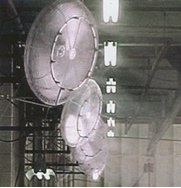 I occasionally have the opportunity to look at humidification applications where the customer wants to use high pressure misting systems. I actually like working with these systems, they are simple, generally compact, affordable, and easy to install and service. However, they are not the preferable technology for most humidification needs. They work real well as evaporative cooling systems. In fact, that is their drawback when applied as humidification. The process of evaporating room temperature water, even atomized, takes a lot of BTUs from the environment, and thus cools as it humidifies. This is perfect for the Southwest US in the dry summer. But it can be problematic in most other industrial humidification situations. The reason being that humidification is most needed when the air is dry, and in most cases that occurs in colder weather when the the contracted air doesn’t hold much moisture. Misting systems, with their accompanying evaporative cooling will humidify the air, but they will cool it as well. Which requires additional heated air, which is dry and soaks up the recently added vapor, etc….
I occasionally have the opportunity to look at humidification applications where the customer wants to use high pressure misting systems. I actually like working with these systems, they are simple, generally compact, affordable, and easy to install and service. However, they are not the preferable technology for most humidification needs. They work real well as evaporative cooling systems. In fact, that is their drawback when applied as humidification. The process of evaporating room temperature water, even atomized, takes a lot of BTUs from the environment, and thus cools as it humidifies. This is perfect for the Southwest US in the dry summer. But it can be problematic in most other industrial humidification situations. The reason being that humidification is most needed when the air is dry, and in most cases that occurs in colder weather when the the contracted air doesn’t hold much moisture. Misting systems, with their accompanying evaporative cooling will humidify the air, but they will cool it as well. Which requires additional heated air, which is dry and soaks up the recently added vapor, etc….
I find it much better to use steam injection for humidification. This of course has its problems as well, but technically is far superior as the moisture being absorbed is already at steam temperature and thus doesn’t require the loss of BTUs from the surroundings. The problems mostly come in sourcing the steam for usage. Injecting boiler steam is the easiest method, but it results in a loss of boiler capacity and some (albeit a slight amount) of water treatment chemicals. An alternative to that is indirect, or steam-to-steam, systems that utilize heat exchangers to heat and inject a separate water source, thus saving on boiler capacity, boiler water, and treatment chemicals. A bigger and more frequent problem is the lack of steam onsite altogether. There are simply less and less building and utility systems utilizing steam. This can be remedied with a small boiler or steam generation systems, or packaged humidifier systems. Technically these are more efficient than misting systems in general. However, the upfront costs are typically higher. Up-selling to these systems can be difficult depending on the application and specific customer needs.
The typical industrial misting system consists of a high pressure pump @ 800-1200psig, feed lines, injection nozzles, and sometimes fans depending on the space and needs. Some systems utilize stainless steel feed lines, typically mounted above worker spaces with injector nozzles at predetermined distances and no fans. Others will utilize fans with nozzle rings face-mounted. These systems are very applicable in high heat, low humidity environments, low worker-per-square-foot areas, and milder climates. I have found several applications in flammable locations where low humidity causes static electricity and danger of explosions. This has been a good technology for these applications and in low budget situations.
As in all things mechanical, applying these systems depends on an infinite number of variables. While ultimately I prefer steam injection, high pressure misting is an acceptable alternative.
